Abbreviation Dor Declination −65 Bayer/Flamsteed designation 14 Stars with planets 5 | Genitive Doradus Right ascension 5 Main stars 3 Messier object 0 | |
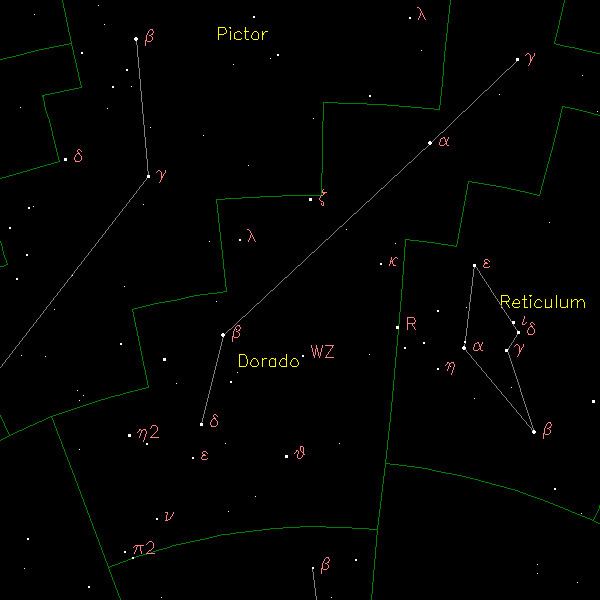 | ||
Pronunciation /dɒˈreɪdoʊ/, genitive /dɒˈreɪdəs/ Similar Mensa, Volans, Reticulum, Pictor, Caelum | ||
Large magellanic cloud and the constellation dorado lmc
Dorado (English pronunciation: /dɒˈreɪdoʊ/) is a constellation in the southern sky. It was named in the late 16th century and is now one of the 88 modern constellations. Its name refers to the dolphinfish (Coryphaena hippurus), which is known as dorado in Portuguese, although it has also been depicted as a swordfish. Dorado contains most of the Large Magellanic Cloud, the remainder being in the constellation Mensa. The South Ecliptic pole also lies within this constellation.
Contents
- Large magellanic cloud and the constellation dorado lmc
- History
- Stars
- Deep sky objects
- Equivalents
- Namesakes
- References
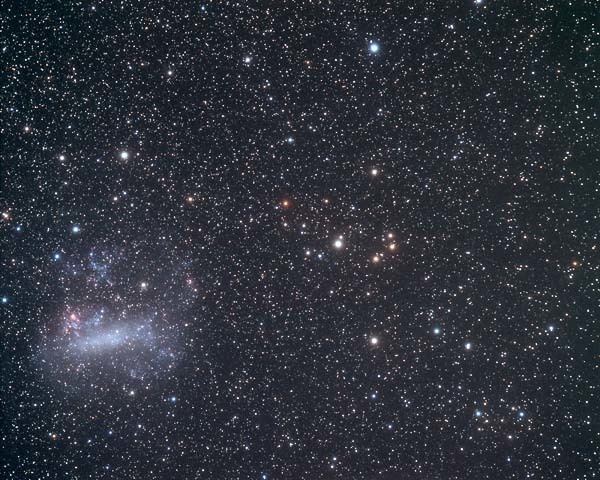
Even though the name Dorado is not Latin but Portuguese, astronomers give it the Latin genitive form Doradus when naming its stars; it is treated (like the adjacent asterism Argo Navis) as a feminine proper name of Greek origin ending in -ō (like Io or Callisto or Argo), which have a genitive ending -ūs.

History
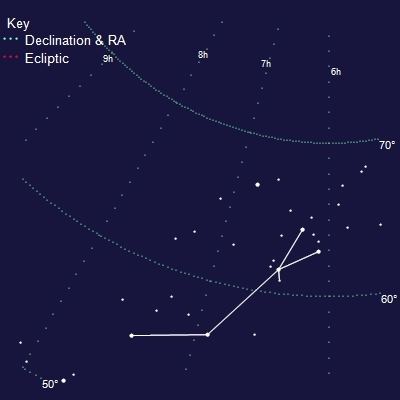
Dorado was one of twelve constellations named by Petrus Plancius from the observations of Pieter Dirkszoon Keyser and Frederick de Houtman, and it first appeared on a 35-centimeter-diameter (14 in) celestial globe published in 1597 (or 1598) in Amsterdam by Plancius with Jodocus Hondius. Its first depiction in a celestial atlas was in Johann Bayer's Uranometria of 1603 where it was also named Dorado. Dorado has been represented historically as a dolphinfish and a swordfish; the latter depiction is inaccurate. It has also been represented as a goldfish. The constellation was also known in the 17th and 18th century as Xiphias, the swordfish, first attested in Johannes Kepler's edition of Tycho Brahe's star list in the Rudolphine Tables of 1627. The name Dorado ultimately become dominant and was adopted by the IAU.
Stars
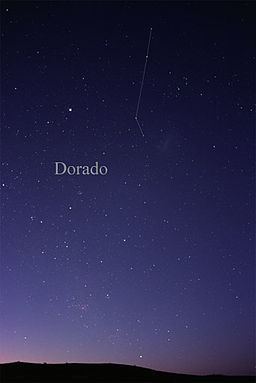
Alpha Doradus is a blue-white star of magnitude 3.3, 176 light-years from Earth. It is the brightest star in Dorado. Beta Doradus is a notably bright Cepheid variable star. It is a yellow-tinged supergiant star that has a minimum magnitude of 4.1 and a maximum magnitude of 3.5. One thousand and forty light-years from Earth, Beta Doradus has a period of 9 days and 20 hours.
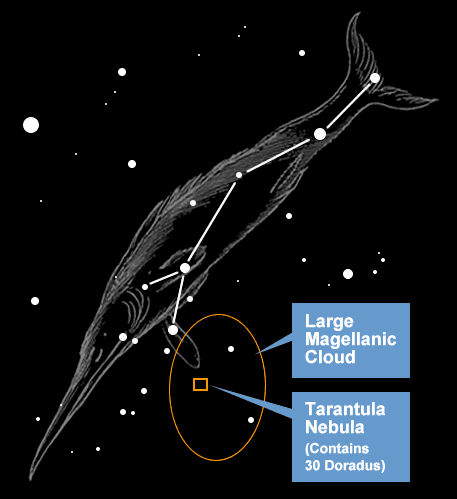
R Doradus is one of the many variable stars in Dorado. S Dor, 9.721 hypergiant in the Large Magellanic Cloud, is the prototype of S Doradus variable stars. The variable star R Doradus 5.73 has the largest known apparent size of any star other than the Sun. Gamma Doradus is the prototype of the Gamma Doradus variable stars.
Supernova 1987A was the closest supernova to occur since the invention of the telescope. SNR 0509-67.5 is the remnant of an unusually energetic Type 1a supernova from about 400 years ago.
HE 0437-5439 is a hypervelocity star escaping from the Milky Way/Magellanic Cloud system.
Dorado is also the location of the South Ecliptic pole, which lies near the fish's head. The pole was called "Polus Doradinalis" by Willem Jansson Blaeu.
Deep-sky objects
Because Dorado contains part of the Large Magellanic Cloud, it is rich in deep sky objects. The Large Magellanic Cloud, 1,000 light-years in diameter, is a satellite galaxy of the Milky Way Galaxy, located at a distance of 179,000 light-years. It has been deformed by its gravitational interactions with the larger Milky Way. In 1987, it became host to SN 1987A, the first supernova of 1987 and the closest since 1604. This 25,000-light-year-wide galaxy contains over 10,000 million stars. All coordinates given are for Epoch J2000.0.
Equivalents
In Chinese astronomy, the stars of Dorado are located in two of Xu Guangqi's Southern Asterisms (近南極星區, Jìnnánjíxīngōu): the White Patches Attached (夾白, Jiābái) and the Goldfish (金魚, Jīnyú).
